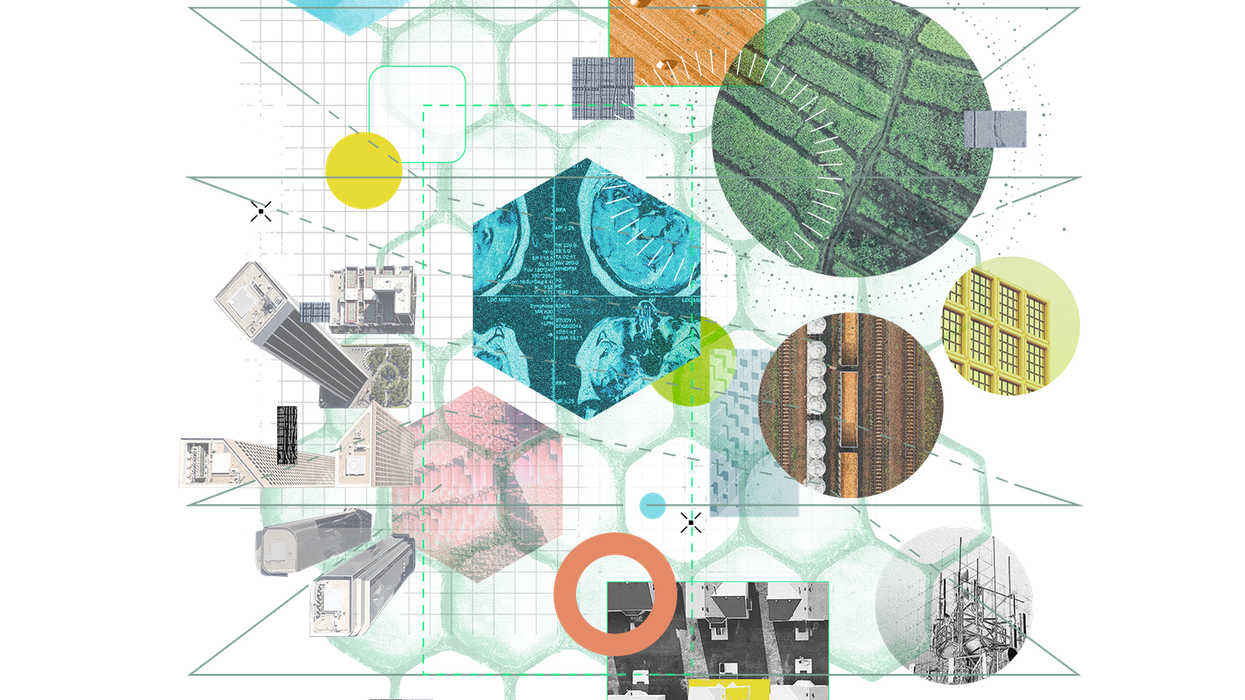
Episode 4: Broken (supply) chains
Listen: "Other than the impacts of the pandemic, which are easing, and from Russia/Ukraine, I'd say that the greatest risk to global supply chains today and moving forward will likely be from the U.S. China relationship, and the movement towards selective decoupling," says Jon Lang, Director for Trade and Supply Chains at Eurasia Group. In the latest episode of Living Beyond Borders, Lang is joined by Charlie Reinhard, Head of Investment Strategy for North America at Citi Global Wealth Investments, to discuss how global supply chains have largely adapted to and moved on from changes that occurred during the global pandemic.
Transcript: Episode 4: Broken (supply) chains
Disclosure: The opinions expressed by Eurasia Group analysts in this podcast episode are their own, and may differ from those of Citigroup Inc and its affiliates.
Jon Lang: Other than the impacts of the pandemic, which are easing, and from Russia/Ukraine, I'd say that the greatest risk, to global supply chains today and moving forward will likely be from the U.S.-China relationship, the movement towards, I would say, selective decoupling. And you know, this relationship really presents a two-way risk from both China and from the U.S.
Charlie Reinhard: I think it makes sense for firms to reassess the value of their suppliers and their vendors; to cut costs where they can, to free up resources that could be utilized to build customer loyalty, and to be very, very relevant with the target audience during an economic downturn. All of this has to happen thoughtfully.
Shari Friedman: Welcome to Living Beyond Borders, a podcast from Citi Global Wealth Investments and GZERO Media. On this program, we examine global risks and opportunities from the angles of both politics and economics. I'm Shari Friedman, Managing Director of Climate and Sustainability at Eurasia Group.
Every morning we wake up, we get out of bed, we make breakfast - or some people just make coffee - we get dressed, we log in, or we head to the office. Each stage of that process, and throughout the rest of the day, we rely on products that we bought locally or had delivered to our house, but that were probably made thousands of miles away: from the sheets to the coffee, to the cars we drive, or the shoes we wear to the subway.
Over decades, the costs of many goods like these have decreased or they've stayed consistent, and that's in large part thanks to globalization and the use of ever more efficient supply chains and just-in-time delivery models.
Then came the global pandemic, which brought this efficiency to a grinding halt. And we learned how vulnerable the system was. A delay at any point in this very complicated supply chain can lead to months of waiting time on refrigerators or couches or whatever it is that you're trying to purchase.
Supply chains have somewhat rebounded since 2020, although prices are still high and there's still some glitches. And now, industries are facing new challenges like the war in Ukraine, a rapidly evolving regulatory environment, and in particular, increasing geopolitical tensions between the U.S. and China.
We're going to talk today about all of this and what it means for businesses, consumers, and investors. I'm joined now by Charlie Reinhard, Head of Investment Strategy for North America at Citi Global Wealth Investments. Welcome Charlie.
Charlie Reinhard: Thank you for having me.
Shari Friedman: And by Jon Lang, Director for Trade and Supply Chains at Eurasia Group. Hi, Jon.
Jon Lang: Hey, Shari.
Shari Friedman: Charlie, let's start with the COVID disruptions. Where are we now in terms of recovery from COVID when it comes to supply chains? Do you feel like we're back to normal?
Charlie Reinhard: Yes, we are largely back to normal. The New York Fed has a Global Supply Chain Pressure Index, and it measures the stresses from global transportation costs, and also regional manufacturing disruptions, in seven major economies around the world. These economies are the United States, China, Japan, the Euro area, South Korea, Taiwan, and also the UK. And as of February, these supply chain pressures came down and are now back to where they were at pre pandemic levels. That doesn’t mean that every industry is back to where it was, but in the aggregate, the supply pressures have receded.
Shari Friedman: That's an interesting index. It seems to cover a high percentage of global GDP. And Jon, you know, there's many factors at play as we emerge from the COVID disruptions, including labor issues. How do you view the state of supply chains right now and what industries do you feel are most affected?
Jon Lang: Yeah. Well, as Charlie mentioned, to some degree, there's a great deal of difference between the degree to which we've seen supply-chain easing based on industry. In aggregate, however, as Charlie mentioned, we have seen a good deal of easing, and it's important to remember that the COVID supply-chain story and the disruption story is both a supply-side and the demand-side story.
So, if we look at both of those independently, on the supply side, which really faced a lot of the COVID-related disruptions at the height of the pandemic - that's where we've seen just the fact that the pandemic has moved to an endemic phase in a number of countries, that policy to contain the spread of the pandemic has eased. This is where we have seen reflected easing in those supply chains.
There are a few standouts, however. Particularly in the United States, you see on the labor side, a number of outstanding risks and not necessarily because of broad sick-outs, but we still find ourselves in a tighter labor market in the U.S. Those have had impacts in supply-chain logistics, particularly trucking and in warehousing staffing as well. Both of those continue to be, I would say, while the broader narrative has improved, sticking points to some degree on the supply side of the supply-chain easing picture.
So if you look at labor specifically, we all saw last November the threat of a rail strike in the United States created such an issue that Congress did intervene to support a resolution there. Just at the end of last week, we saw a 24-hour strike at the critical ports of Los Angeles and Long Beach; I think between the two that accounts for 40% or so of containerized imports into the United States.
This is a piece of a much longer story with U.S. West Coast ports in the midst of routine contract renegotiations with those ports' labor unions. To a degree, companies have really, and importers have really, with the anticipation of potential disruptions, begun to mitigate against those risks by diversifying their imports into to East Coast ports even in advance of these talks.
Another sticking point continues to be a historically low warehousing availability. And this really reflects what companies did to initially improve resilience from the outset of the supply-chain disruptions, which was to alter their inventory strategies, so to increase inventory to reduce risk of stock-outs, and this limited warehousing space continues to be an issue today.
Shari Friedman: Mmhm. So we weren't really set up for these disruptions given our just-in-time. Charlie, on this show we speak a lot about prices and inflation. To what extent are these a result of pent-up demand in the system?
Charlie Reinhard: Inflation is receding, but we do think the calculus has shifted from inflation being more a product of supply chain disruptions into one that is now more reminiscent of pent-up demand. We can see that the individual components of inflation – used car prices, energy prices, and commodity prices have been receding. Of course, they were much higher when the pandemic broke out. And then also during the war in Ukraine when the war first broke out. By contrast, we still have firm prices for transportation services and airline fares. And all of that is related to pent up demand for travel and experiences that individuals are still working through.
Shari Friedman: Jon, going over into the bigger picture to look at some of the longer trends behind these supply-chain shocks, we know what the COVID-19 pandemic did, but why was the system so vulnerable to disruptions like this? I think you touched upon some of it in the lack of warehousing, but if you can kind of look through the system and identify the vulnerabilities, that would be helpful.
Jon Lang: Sure. Well, as you mentioned, COVID really exposed global supply chains, which were built over time for speed, for low cost, for innovation, through market comparative advantage. The supply chain really worked well in a relatively stable trading world, which we saw for decades you know with the general international policy agreement on the Washington consensus, the preference for trade liberalization, and the adherence to the multilateral trading order. And this created the right environment for increasing globalized supply chains.
But during the same period, we didn't see any major black swan events on the level of the rapid, global spread of the COVID-19 pandemic impacting not one region or portion of the supply chain, but essentially impacting the entirety of the global supply chain, from sourcing to manufacturing to distribution, and across all geographies nearly simultaneously. And these challenges were compounding in nature, and as you would address one issue, the added pressure from opening that constraint would reveal constraints on and on downstream.
And it's within this historically stable environment that multinationals built supply chains in the just-in-time model that you referenced, with reduced lead times and low cost. And following the initial spread of the pandemic, this supply-chain strategy became an early corporate casualty of the pandemic, as companies rushed to build resilience into the supply chain you know with a move to what has come to be called just-in-case strategy. This was really highlighted with a heavy focus on increased lead times, significant adjustments to inventories, as we've discussed in the warehousing context.
It's also inadvertently served to reduce demand pressures on global supply chain logistics as retailers particularly are still working through built-up inventory in those historically high warehousing levels as opposed to heavy import reliance recently. So once again, taking some of the pressure off those upstream logistics.
While the development of globalized just-in-time supply chains was an international strategic approach, given the relatively stable global trade and commercial environment over the last several decades, you know another unintended factor likely served to mask the true brittle nature of this strategic approach. And that's the issue of supply chain transparency. And transparency is one of those themes which I think will prove to be one of the most important supply chain considerations moving forward and I believe contributed to how global supply chains became so vulnerable, reflecting the lack of full awareness of that risk profile.
Shari Friedman: And that risk profile, of course, goes across – like, it's not just, are you going to be able to get your materials, you're going to see that compounded, right, with the social and the environmental pieces. Is that right?
Jon Lang: Yeah, that's correct. I mean really, so the transparency theme right now, is creating a two-pronged risk profile for companies; both reputational, as you mentioned, regarding ESG concerns and supply chains, environmental, forced labor, human rights. But also increasingly we're seeing countries, particularly the United States, Europe, Japan, and others, beginning to legislate on forcing companies to proactively identify these issues presented by a lack of transparency in supply chains.
Shari Friedman: Right. And Charlie, you know, Jon was talking about how our entire system was built upon this efficiency that kind of assumed this stability inside of the global structure geopolitically and an ability to get things from place to place very efficiently. And now we've seen some vulnerabilities. How do you think companies are changing in light of the way that they’ve had to adjust so far? What are the lessons that they’ve learned?
Charlie Reinhard: So before the pandemic, as you recall, and as Jon mentioned, cost containment and productivity improvements were the focus of supply chain progress. They're still important, but the disruption brought on by COVID forced companies to focus on their basic business continuity. And to do this, they needed to bolster their resiliency and their flexibility. They had to get far better visibility into their supply networks. They had to act very quickly and upgrade their real-time visibility and their demand planning capabilities. And to do this, they really needed to enhance their digital capabilities. They needed to adopt new supply chain risk management processes.
The challenges led to new alliances and strategic agreements between manufacturers and suppliers such as chip makers as an example. And firms within the same value chain realized that they needed to share data and cooperate more than they ever had before as coordination became of the essence. To do this, they also needed to secure their data that they were sharing. That became incredibly important. And so, this rose to a greater importance for security protection.
Now, as Jon mentioned, companies had to address a number of different bottlenecks, and they in cases had to do this rather creatively. So for example, some companies that were short on storage space, they needed to actually buy their own warehouses. Some shippers that couldn't source containers, sometimes they had to make their own or they had to find others that they could charter. Some had to shift to alternative ports or even to air freight as opposed to shipping by sea.
Some companies had to reformulate their products around the components or the ingredients that they did have on hand or could find. And others had to stockpile the chips and parts and batteries, for example, in the auto space, that they could find in order to have some vehicles available that they could produce and also to sell.
A number of retailers during this time period, they over-ordered to make sure that they had inventory available that they could sell and to prevent stock outs. But later on, this led to a different set of problems such as having to discount certain products for which they had ordered too much or selling seasonal items over two years rather than one year. So some of these adaptations are probably permanent, while others might be temporary. But yes, I do believe that there were quite a number of lessons that were learned as firms adjusted to the challenges that were presented by the period.
Shari Friedman: Yeah, that's interesting. It seems like as we're moving from this just-in-time to what Jon called the just-in-case, there's going to be adjustments that are just going to be unavoidable. And as we know just as the pandemic really created a shift in global supply chains, then we got another massive hit from the unforeseen war in Ukraine.
Jon, how have we seen this impact on global supply chains? What has this looked like specifically between countries and what has the effect of sanctions been?
Jon Lang: Yeah, as we've touched on, there are a number of different geopolitical macroeconomic impacts, which have roiled global supply chains, including certainly Russia's invasion of Ukraine. The supply chain impact here really depends a bit more on where you sit. As unlike the pandemic, it has not had the same effect on nearly all points along the product value chain from sourcing to product consumption.
But geographic impacts have been felt much more acutely in places like Europe and across the global south where Russia and Ukraine export significant portions of agricultural commodities and energy as well and where disruptions have had a bit more of an outsized impact. The trade and financial sanctions themselves have been biting and are a testament to your point about the strengthening alliances, to strengthen transatlantic trade policy cooperation through the Trade and Technology Council.
There are three areas of impact potentially here to supply chains from sanctions, as you mentioned, but also from Russian unilateral limiting of raw materials exports, as well as corporate reputational risk leading companies to independently disengage from the Russian market, even if not required to do so by sanctions. And the sanctions package is really most directly impacting those companies that are working to try to remain in operation in Russia, complicating imports and cross-border payments for treasury management purposes.
But for the country overall and its domestic industry, strong technology sanctions will, over time, degrade Russia's military and technological capabilities. In some areas, however, sanctions’ impact to Russian exports have been offset by export increases to other non-sanctioning countries seeking, for example, lower cost Russian energy, which has partially offset some of that sanction's impact.
You know, additionally, Russia has signaled its willingness to use export restrictions of its vast raw materials for leverage. And while this remains a possibility, I think this likelihood, regardless of threats from Moscow, is limited owing to Russia's need for continued revenue from raw materials and energy exports. But you know, we can see this through the actions, such as the renewed grain export deal last month, continuing to allow Ukrainian agricultural and fertilizer exports via the humanitarian corridors from ports along the Black Sea.
But really putting sanctions aside, companies are also taking or have taken unilateral action to insulate from some of that reputational risk from continued sourcing from Russia. A number of companies have elected to suspend business with Russia despite sanctions not specifically targeting their activities. Things like Boeing's early decision to suspend titanium sourcing from Russia and the choice of a number of large bulk maritime containerships to no longer take bookings from Russian ports.
But while the direct supply chain impacts from Russia and Ukraine are more, from the perspective of the U.S., more limited than the pandemic, certainly, and geographically dependent that the invasion has certainly proved yet another challenge for global supply chains and a driver of the need to improve resilience.
Shari Friedman: Going back over to Charlie, now we have this other kind of more gradual movement, which is a shift in the regulatory environment. And I'm curious to know how the changes in the regulatory environment are affecting supply chain. So for example, ESG, environmental, social, and governance and reputational and economic risks that Jon had touched upon.
Charlie Reinhard: You know every firm needs to keep current on the regulations that could impact its supply chain and its reputation, and it's complicated. As Jon mentioned, there are sanctions programs on Russia, but also on other countries as well. We've got the Uyghur Forced Labor Prevention Act, and also shell companies and shelf companies can sometimes conceal who is actually the beneficial owner of a company, who actually has control or a high ownership stake in a company. So it's become quite a challenge, but firms do need to rise to the challenge.
You know, around the world, we're seeing, especially in Europe, for example, the European Corporate Sustainability Reporting Directive expanded greatly the requirements within the EU for ESG reporting. Germany, on top of that, has their own supply chain act to further bolster the due diligence on human rights and the environment that firms need to address. They have to track their emissions, their diversity, and also some other ESG data.
And of course, they need to collect all of this data and gather it and assemble it from their suppliers. In the United States, there was an effort last year the SEC proposed its own version of expanding ESG disclosure regulations. It didn't pass yet, but as you mentioned, this is a slower moving dynamic that firms do need to contend with. And of course, you don't want to be the firm that is making the news for all the wrong reasons by running afoul of regulatory laws or being less skillful than your competition in navigating the terrain.
Shari Friedman: Yeah, indeed, indeed. And you're starting to see, the implications are different by geography. The pace on which a lot of these regulations are coming forth are different on geography. But we are seeing a convergence as you're noting, and Jon, kind of going back to these very broad geopolitical trends, we've seen a couple of shifts that were unexpected, and now, we're starting to see a shift that could also cause significant disruptions on supply chains. We're seeing this balance of power shift between the U.S. and China. Are we seeing a true regression in globalization toward more dependency on regional or national alliances? And then, what is this going to mean for the global flow of goods?
Jon Lang: Yeah, other than the impacts of the pandemic, which are easing, and from Russia, Ukraine, I'd say that the greatest risk, as you know, to global supply chains today and moving forward will likely be from the U.S.-China relationship, the movement towards, I would say, selective decoupling - certainly between China and Western countries. And this relationship really presents two-way risk from both China and from the U.S., which is the most forward-leaning country in its use of policy tools to incentivize supply chain resilience, certainly for national security purposes.
To answer your question about, are we seeing a regression from globalization? I would say we're seeing a reworking of what we previously considered globalization. You have to remember that, historically and including today, a lot of global trade is actually with neighbors and partners within a country's region. So a lot of people in the United States may consider, when asked, that China is the greatest U.S. trading partner globally, when, in fact, it's Mexico and Canada.
Historically, with the exception of a few major trading partners in the world, trade does tend to be more regional in nature. I think a lot of companies are pursuing, particularly when it comes to selective decoupling or the commercial impacts and trade impacts to the relationship between the United States and China, and China and the West, are choosing to improve resilience in the medium to long-term through redundancy efforts.
So this has become popular in the China plus one model, for example, or the make in China for China, where companies will manufacture goods to service the Chinese consumer market within China, while, at the same time, investing in redundant sourcing and manufacturing outside of China on a regional basis perhaps, to service other economies.
And this is reflective of an interest in reducing risk from trade tensions, risk from differentiated standards in product development. So this is something that we see will be increasing as time moves forward. Not to say this is the end of globalization by any means, but a bit of a restructuring from the highly globalized supply chains that we've seen in the past.
Shari Friedman: Won't that increase prices, if we're seeing that level of redundancy? I mean the purpose of a lot of this globalization without redundancy was price reduction. So what do you think that effect is going to be?
Jon Lang: Yes, I think the investment in that redundancy may very well will lead to price increases for the consumers, particularly for low margin goods, think textiles, footwear, things like that. But I think, from an economics perspective, the answer to that might be that, particularly national security concerns, and this is very much the mindset of policymakers, particularly in Washington, that those national security concerns are externalities, which were not baked into the final price of consumer goods historically. That additional price will be reflective of the changing nature of the geostrategic position in the United States vis-a-vis China in the world.
Shari Friedman: So, Charlie, what are you seeing in terms of tensions with China and how they're going to be affecting the global economy?
Charlie Reinhard: I think China's going to be affecting the global economy in two different ways. You know, we're all connected in terms of terms of trade. And some of the areas with which we're connected, we're probably going to continue the way that we are. But in other categories, there are certain flashpoints around technology where, for national security issues, we are going to be going in different directions.
The other way that China is going to affect a global economy this year is simply the fact that it's reopening and has been loosening its monetary policy, while the rest of the world has been tightening its monetary policy. So we're actually of the view that China's economy will be about the only one that accelerates this year versus what we experienced last year.
Shari Friedman: Charlie, in an ideal world – you know, you're looking at placing capital. And so, if you were going to decide how you see companies and governments and individuals reacting, what would you see as an ideal way that all of these would react to strengthen global supply chains?
Charlie Reinhard: Well, I think companies and governments need to control what they can. For example, companies can use digital technology to get data faster, and to bolster their ability to get early warning signs when something is off. They can automate to improve their agility and resilience.
So for example, they could use this technology to automate how they're going to restock at a retailer or how they're going to assign truck routes, for example, at a logistics firm. There's a huge incentive, I believe, to substitute capital for labor. Jon spoke at the beginning of the call about how labor markets have been relatively tight, but we can use robotics and artificial intelligence to create teams of people and tools to enhance productivity, and contain costs in the future. So those are some of the longer term things that firms can do.
Because we are envisioning an economic slowdown this year, there are also some cyclical things. I think it makes sense for firms to reassess the value of their suppliers and their vendors, and to cut costs where they can, to free up resources that could be utilized to build customer loyalty, and to be very, very relevant with the target audience during an economic downturn.
All of this has to happen thoughtfully. You know, we have seen capital spending budgets rise rapidly during the pandemic in the last couple of years. And so you don't want to over-extended heading into an economic downturn, but with interest rates higher and also some inventories higher than what we want to be, this is a really good time for firms to address their working capital.
So those are just a couple of suggestions on the corporate side, both long term and where we are in the cycle. In terms of governments, I think that there's discussions that we can have in order to bolster cooperation. I think is going to continue to be very important in the future. I think we've all recognized in the last few years that for better or worse we're incredibly connected. Even if we make attempts to increase our onshoring and our reshoring and our friend shoring and we reroute certain aspects of our supply chains. We are incredibly connected. So the degree to which cooperation can be fostered through discussions and trade agreements and symposiums. I think all of that's very important for laying the kind of landscape in which we could all prosper in the future.
Shari Friedman: Right. And this gets to what Jon was saying as kind of limited decoupling that there's going to be kind of strategic and limited decoupling, because it's very hard to do anything that would be complete given our interconnectivity. And Jon, do you agree with what Charlie just outlayed, and what are you seeing happening globally?
Jon Lang: Yeah, I do agree with Charlie, and I think to Charlie's point, about achieving some of those production efficiencies for longer term cost savings will be critical, because there will be cost increases as companies seek to diversify and improve their own supply chain resilience through redundant sourcing and manufacturing all comes with a cost.
That said, supply chain diversification is not something that happens overnight. This is something that happens in the medium to long term with careful planning and investment, seeking new opportunities for investment in third party countries that may have closer alignment with the consumer market, that then would be less subject to adverse policy activity, particularly related to the selective sign of U.S. decoupling. And let me also add to that, policymakers, they're not pursuing a strategy of complete decoupling with China.
You know, as Charlie noted, we're too intertwined for that. There are commercial areas where the U.S. and China can certainly pursue and maintain activity. But from the standpoint of the policymakers, some of those other areas on the geopolitical side will be focused on technologies, dual use capacity products as well. We've seen putting technology aside, and we've certainly seen a lot of investment in particularly G7 markets with the rise of industrial policy and domestic subsidies to encourage reshoring and onshoring more broadly.
The U.S. certainly encourages friend shoring and nearshoring. We've certainly seen this begin to emerge in some of that trade data. Stand out certainly include places like Vietnam and India, and a number of emerging markets that are trying to move up the product value chain. But broadly speaking, aggregate trade data still maintains that we have a robust trading relationship with China, and a lot of those top line trade numbers have not changed significantly.
There's also a lot of reasons that companies would like to remain in China. Certainly, their consumer market is one. China is working to vertically integrate a number of its industries to discourage redundant investment outside of China. The raw materials in China. The maturity of China's infrastructure is certainly a bonus for companies maintaining a manufacturing presence in China, putting aside national security concerns that may not be reflected elsewhere.
But gradually speaking, we are beginning to see this trend where companies are looking to third markets, particularly if you're looking to service the U.S. consumer market, those markets that have a robust trade relationship, preferably with market access provisions to the U.S. as a sign of where things are moving in the future.
Shari Friedman: So it's interesting, I'm hearing from both of you guys that this shift is going to be not just as everybody thinks this geographic shift, but it's actually going to be also on the part of companies and supply chains, a behavioral shift on how they operate, how they create redundant systems, and perhaps the geographic shift will happen, but not be so stark as people tend to paint it.
Charlie, we'll close with you. We've talked a lot about a dependence on systems that are vulnerable, a dependence on many goods that we've expected to come in very cheaply, and now we have these shifting geopolitical relationships. What does this all mean for investors and the economy overall?
Charlie Reinhard: I think investors recognize that the world is a highly connected place. And so there are going to on occasion be headlines that could take markets up or down and create some short-term volatility. That being said, I think investors also recognize that this connectivity has led to tremendous progress in terms of the goods and services that are available, the medicines that we take, the technology that we utilize, and all of this is helping us to live better lives over the course of time. And these technologies and these innovations are worth investing in.
And so for investors, I would advise that they take a long-term focus and recognize that over time the global economy is going to grow, the U.S. economy is going to grow, and when that happens, profits are going to grow as well. And so it may take some time, investing is two steps forward, one step back, but over time, we're all going to reach higher living standards with more robust supply chains backing up these efforts.
Shari Friedman: Well, that's ending on a good high note. Charlie Reinhard, Head of Investment Strategy for North America at Citi Global Wealth Investments.. And Jon Lang, Director of Trade and Supply Chains at Eurasia Group. Thanks to you both.
Charlie Reinhard: Thank you.
Jon Lang: Thank you.
SHARI FRIEDMAN: And that's it for this episode of Living Beyond Borders. Listen to all of this season's episodes by heading to gzeromedia.com and click on the Living Beyond Borders tab. Or you can find episodes in the GZERO World Podcast feed wherever you get your podcasts. For GZERO, I'm Shari Friedman. Thanks for listening.

















